An Investigation to Identify the Effectiveness of Socioeconomic, Demographic, and Buildings’ Characteristics on Surface Urban Heat Island Patterns
Abstract
:1. Introduction
1.1. Significance of Research
1.2. Problem Statement
1.3. Research Objectives
2. Literature Review
Research Gap
3. Methodology
3.1. Study Area
3.2. SUHI Development
3.2.1. Landsat Data
3.2.2. Land Use Land Cover (LULC)
3.2.3. Calculating LST
3.2.4. SUHI Estimation
3.3. Identification and Correlation of Factors
3.3.1. Socioeconomic Factors
3.3.2. Demographic Factors
3.3.3. Building Factors
3.4. Analysis and Results
4. Discussion
4.1. Socioeconomic Correlations
4.2. Demographic Correlations
4.3. Building Attributes Correlations
5. Conclusions and Recommendations
Author Contributions
Funding
Acknowledgments
Conflicts of Interest
References
- Sidiqui, P.; Huete, A.; Devadas, R. Spatio-Temporal Mapping and Monitoring of Urban Heat Island Patterns Over Sydney, Australia Using MODIS and Landsat-8. In Proceedings of the 2016 4th International Workshop on Earth Observation and Remote Sensing Applications (EORSA), Guangzhou, China, 4–6 July 2016; pp. 217–221. [Google Scholar] [CrossRef]
- Roth, M.; Oke, T.R.; Emery, W. Satellite-derived urban heat islands from three coastal cities and the utilization of such data in urban climatology. Int. J. Remote Sens. 1989, 10, 1699–1720. [Google Scholar] [CrossRef]
- Bonafoni, S.; Anniballe, R.; Pichierri, M. Comparison Between Surface and Canopy Layer Urban Heat Island Using MODIS Data. In Proceedings of the 2015 Joint Urban Remote Sensing Event (JURSE), Lausanne, Switzerland, 30 March–1 April 2015; pp. 1–4. [Google Scholar] [CrossRef]
- Clinton, N.; Gong, P. MODIS detected surface urban heat islands and sinks: Global locations and controls. Remote Sens. Environ. 2013, 134, 294–304. [Google Scholar] [CrossRef]
- Oke, T.R. The energetic basis of the urban heat island. Q. J. R. Meteorol. Soc. 1982, 108, 1–24. [Google Scholar] [CrossRef]
- Voogt, J.A.; Oke, T.R. Thermal remote sensing of urban climates. Remote Sens. Environ. 2003, 86, 370–384. [Google Scholar] [CrossRef]
- Mirzaei, P.A.; Haghighat, F. Approaches to study Urban Heat Island—Abilities and limitations. Build. Environ. 2010, 45, 2192–2201. [Google Scholar] [CrossRef]
- Wilby, R.L. Past and projected trends in London’s urban heat island. Weather 2003, 58, 251–260. [Google Scholar] [CrossRef]
- Erdem, U.; Cubukcu, K.M.; Sharifi, A. An analysis of urban form factors driving Urban Heat Island: The case of Izmir. Environ. Dev. Sustain. 2020, 23, 7835–7859. [Google Scholar] [CrossRef]
- Borden, K.A.; Cutter, S.L. Spatial patterns of natural hazards mortality in the United States. Int. J. Health Geogr. 2008, 7, 64. [Google Scholar] [CrossRef] [Green Version]
- Hsu, A.; Sheriff, G.; Chakraborty, T.; Manya, D. Disproportionate exposure to urban heat island intensity across major US cities. Nat. Commun. 2021, 12, 2721. [Google Scholar] [CrossRef]
- Hu, Y.; Hou, M.; Jia, G.; Zhao, C.; Zhen, X.; Xu, Y. Comparison of surface and canopy urban heat islands within megacities of eastern China. ISPRS J. Photogramm. Remote Sens. 2019, 156, 160–168. [Google Scholar] [CrossRef]
- Ramamurthy, P.; Li, D.; Bou-Zeid, E. High-resolution simulation of heatwave events in New York City. Arch. Meteorol. Geophys. Bioclimatol. Ser. B 2015, 128, 89–102. [Google Scholar] [CrossRef]
- Arnfield, A.J. Two decades of urban climate research: A review of turbulence, exchanges of energy and water, and the urban heat island. Int. J. Clim. 2003, 23, 1–26. [Google Scholar] [CrossRef]
- Li, Y.; Sun, Y.; Li, J.; Gao, C. Socioeconomic drivers of urban heat island effect: Empirical evidence from major Chinese cities. Sustain. Cities Soc. 2020, 63, 102425. [Google Scholar] [CrossRef]
- Intergovernmental Panel on Climate Change (IPCC). IPCC: Climate Change 2021: The Physical Science Basis; IPCC: Geneva, Switzerland, 2021. [Google Scholar]
- Ahmed, S. Assessment of urban heat islands and impact of climate change on socioeconomic over Suez Governorate using remote sensing and GIS techniques. Egypt. J. Remote Sens. Space Sci. 2017, 21, 15–25. [Google Scholar] [CrossRef]
- Chen, Z.; Gong, C.; Wu, J.; Yu, S. The influence of socioeconomic and topographic factors on nocturnal urban heat islands: A case study in Shenzhen, China. Int. J. Remote Sens. 2011, 33, 3834–3849. [Google Scholar] [CrossRef]
- Weng, Q.; Lu, D.; Schubring, J. Estimation of land surface temperature–vegetation abundance relationship for urban heat island studies. Remote Sens. Environ. 2004, 89, 467–483. [Google Scholar] [CrossRef]
- Shashua-Bar, L.; Hoffman, M.E. Vegetation as a climatic component in the design of an urban street: An empirical model for predicting the cooling effect of urban green areas with trees. Energy Build. 2000, 31, 221–235. [Google Scholar] [CrossRef]
- Xu, H. Analysis of Impervious Surface and its Impact on Urban Heat Environment using the Normalized Difference Impervious Surface Index (NDISI). Photogramm. Eng. Remote Sens. 2010, 76, 557–565. [Google Scholar] [CrossRef]
- Yuan, F.; Bauer, M.E. Comparison of impervious surface area and normalized difference vegetation index as indicators of surface urban heat island effects in Landsat imagery. Remote Sens. Environ. 2006, 106, 375–386. [Google Scholar] [CrossRef]
- Chen, X.-L.; Zhao, H.-M.; Li, P.-X.; Yin, Z.-Y. Remote sensing image-based analysis of the relationship between urban heat island and land use/cover changes. Remote Sens. Environ. 2006, 104, 133–146. [Google Scholar] [CrossRef]
- Deng, Y.; Chen, R.; Xie, Y.; Xu, J.; Yang, J.; Liao, W. Exploring the Impacts and Temporal Variations of Different Building Roof Types on Surface Urban Heat Island. Remote Sens. 2021, 13, 2840. [Google Scholar] [CrossRef]
- Taha, H.; Akbari, H.; Rosenfeld, A.; Huang, J. Residential cooling loads and the urban heat island—the effects of albedo. Build. Environ. 1988, 23, 271–283. [Google Scholar] [CrossRef]
- Khan, A.; Chatterjee, S.; Weng, Y. UHI drivers and mapping the urban thermal environment. Urban Heat Isl. Modeling Trop. Clim. 2021, 69–115. [Google Scholar] [CrossRef]
- Roman, K.K.; O’Brien, T.; Alvey, J.; Woo, O. Simulating the effects of cool roof and PCM (phase change materials) based roof to mitigate UHI (urban heat island) in prominent US cities. Energy 2016, 96, 103–117. [Google Scholar] [CrossRef]
- Zhao, Q.; Myint, S.W.; Wentz, E.A.; Fan, C. Rooftop Surface Temperature Analysis in an Urban Residential Environment. Remote Sens. 2015, 7, 12135–12159. [Google Scholar] [CrossRef] [Green Version]
- Jusuf, S.K.; Wong, N.H.; Hagen, E.; Anggoro, R.; Hong, Y. The influence of land use on the urban heat island in Singapore. Habitat Int. 2007, 31, 232–242. [Google Scholar] [CrossRef]
- Sharifi, E.; Lehmann, S. Comparative Analysis of Surface Urban Heat Island Effect in Central Sydney. J. Sustain. Dev. 2014, 7, 23–34. [Google Scholar] [CrossRef] [Green Version]
- Sharifi, E.; Lehmann, S. Comparative analysis of surface urban heat island effect of rooftops and streetscapes in central sydney. J. Urban Environ. Eng. 2015, 9, 3–11. [Google Scholar] [CrossRef]
- Li, Y.; Schubert, S.; Kropp, J.P.; Rybski, D. On the influence of density and morphology on the Urban Heat Island intensity. Nat. Commun. 2020, 11, 2647. [Google Scholar] [CrossRef]
- Ng, E.; Chen, L.; Wang, Y.; Yuan, C. A study on the cooling effects of greening in a high-density city: An experience from Hong Kong. Build. Environ. 2012, 47, 256–271. [Google Scholar] [CrossRef]
- Huang, G.; Zhou, W.; Cadenasso, M. Is everyone hot in the city? Spatial pattern of land surface temperatures, land cover and neighborhood socioeconomic characteristics in Baltimore, MD. J. Environ. Manag. 2011, 92, 1753–1759. [Google Scholar] [CrossRef] [PubMed]
- Tang, J.; Di, L.; Xiao, J.; Lu, D.; Zhou, Y. Impacts of land use and socioeconomic patterns on urban heat Island. Int. J. Remote Sens. 2017, 38, 3445–3465. [Google Scholar] [CrossRef]
- Yao, R.; Wang, L.; Huang, X.; Niu, Y.; Chen, Y.; Niu, Z. The influence of different data and method on estimating the surface urban heat island intensity. Ecol. Indic. 2018, 89, 45–55. [Google Scholar] [CrossRef]
- Chen, S.; Yu, Z.; Liu, M.; Da, L.; Hassan, M.F.U. Trends of the contributions of biophysical (climate) and socioeconomic elements to regional heat islands. Sci. Rep. 2021, 11, 12696. [Google Scholar] [CrossRef]
- Zhou, D.; Xiao, J.; Bonafoni, S.; Berger, C.; Deilami, K.; Zhou, Y.; Frolking, S.; Yao, R.; Qiao, Z.; Sobrino, J.A. Satellite Remote Sensing of Surface Urban Heat Islands: Progress, Challenges, and Perspectives. Remote Sens. 2019, 11, 48. [Google Scholar] [CrossRef] [Green Version]
- Keeratikasikorn, C.; Bonafoni, S. Urban Heat Island Analysis over the Land Use Zoning Plan of Bangkok by Means of Landsat 8 Imagery. Remote. Sens. 2018, 10, 440. [Google Scholar] [CrossRef]
- Jin, M.; Dickinson, R.E.; Zhang, D. The Footprint of Urban Areas on Global Climate as Characterized by MODIS. J. Clim. 2005, 18, 1551–1565. [Google Scholar] [CrossRef]
- Crawford, D.; Timperio, A.; Giles-Corti, B.; Ball, K.; Hume, C.; Roberts, R.; Andrianopoulos, N.; Salmon, J. Do features of public open spaces vary according to neighbourhood socio-economic status? Health Place 2008, 14, 889–893. [Google Scholar] [CrossRef]
- Liu, Y.; Li, Q.; Yang, L.; Mu, K.; Zhang, M.; Liu, J. Urban heat island effects of various urban morphologies under regional climate conditions. Sci. Total Environ. 2020, 743, 140589. [Google Scholar] [CrossRef]
- Thinking of Moving to Geelong? This Framework Will Set the Future of the City—ABC News. Available online: https://www.abc.net.au/news/2021-05-25/government-plan-for-geelong-cbd-future-as-house-population-boom/100156728 (accessed on 13 January 2022).
- Mikkonen, H.G.; Dasika, R.; Drake, J.A.; Wallis, C.J.; Clarke, B.; Reichman, S.M. Evaluation of environmental and anthropogenic influences on ambient background metal and metalloid concentrations in soil. Sci. Total Environ. 2018, 624, 599–610. [Google Scholar] [CrossRef]
- Mayes, E.; Keddie, A.; Moss, J.; Rawolle, S.; Paatsch, L.; Kelly, M. Rethinking inequalities between deindustrialisation, schools and educational research in Geelong. Educ. Philos. Theory 2018, 51, 391–403. [Google Scholar] [CrossRef]
- Relief in Sight for Melbourne after Hottest Day in almost a Year|Australia Weather|The Guardian. Available online: https://www.theguardian.com/australia-news/2021/jan/11/high-bushfire-danger-across-australias-east-as-melbourne-set-for-hottest-day-in-a-year (accessed on 16 January 2022).
- Victoria in 1 January to 31 January 2009. Available online: http://www.bom.gov.au/climate/current/month/vic/archive/200901.summary.shtml (accessed on 16 January 2022).
- The Health Impacts of the January 2014 Heatwave in Victoria”. Available online: https://www.health.vic.gov.au/publications/the-health-impacts-of-the-january-2014-heatwave-in-victoria (accessed on 10 January 2022).
- Department of Environment, Land, Water and Planning. Available online: https://www.delwp.vic.gov.au/ (accessed on 16 January 2022).
- Jiménez-Muñoz, J.C.; Sobrino, J.A.; Skoković, D.; Mattar, C.; Cristóbal, J. Land Surface Temperature Retrieval Methods from Landsat-8 Thermal Infrared Sensor Data. IEEE Geosci. Remote Sens. Lett. 2014, 11, 1840–1843. [Google Scholar] [CrossRef]
- Azzari, G.; Lobell, D. Landsat-based classification in the cloud: An opportunity for a paradigm shift in land cover monitoring. Remote Sens. Environ. 2017, 202, 64–74. [Google Scholar] [CrossRef]
- Australian Bureau of Statistics (ABS), Socioeconomic Disadvantages: Main Features—SOCIO-ECONOMIC INDEXES FOR AREAS (SEIFA) 2016. Available online: https://www.abs.gov.au/websitedbs/censushome.nsf/home/seifa (accessed on 10 January 2022).
- Choi, P.M.; Tscharke, B.; Samanipour, S.; Hall, W.; Gartner, C.; Mueller, J.; Thomas, K.V.; O’Brien, J. Social, demographic, and economic correlates of food and chemical consumption measured by wastewater-based epidemiology. Proc. Natl. Acad. Sci. USA 2019, 116, 21864–21873. [Google Scholar] [CrossRef] [Green Version]
- ABS. Australian Bureau of Statistics Yearbook; ABS: Canberra, Australia, 1961. Available online: http://www.abs.gov.au (accessed on 20 April 2010).
- Rintoul, A.; Livingstone, C.; Mellor, A.P.; Jolley, D. Modelling vulnerability to gambling related harm: How disadvantage predicts gambling losses. Addict. Res. Theory 2012, 21, 329–338. [Google Scholar] [CrossRef]
- Palermo, C.; Walker, K.Z.; Hill, P.; McDonald, J. The cost of healthy food in rural Victoria. Rural Remote Health 2008, 8, 1074. [Google Scholar] [CrossRef]
- Roofprints—City of Greater Geelong|Datasets|Data.gov.au—Beta. Available online: https://data.gov.au/dataset/ds-dga-41527e85-0907-4faf-b5f4-e9655b23d128/details (accessed on 22 January 2022).
- Sen, P.K.; Lindeman, R.H.; Merenda, P.F.; Gold, R.Z. Introduction to Bivariate and Multivariate Analysis. J. Am. Stat. Assoc. 1981, 76, 752. [Google Scholar] [CrossRef]
- Kannipamula, S.J. Assessing the Relative Importance of Predictors in Linear Regression. Eur. J. Mol. Clin. Med. 2020, 7, 970–976. [Google Scholar]
- Australian Bureau of Statistics (ABS), Socioeconomic Disadvantages: Main Features—Interactive Maps. Available online: https://www.abs.gov.au/ausstats/abs@.nsf/Lookup/by%20Subject/2033.0.55.001~2016~Main%20Features~IRSD%20Interactive%20Map~15 (accessed on 5 January 2022).
- Heaviside, C.; Macintyre, H.; Vardoulakis, S. The Urban Heat Island: Implications for Health in a Changing Environment. Curr. Environ. Health Rep. 2017, 4, 296–305. [Google Scholar] [CrossRef] [PubMed]
- Guisan, A.; Zimmermann, N.E. Predictive habitat distribution models in ecology. Ecol. Model. 2000, 135, 147–186. [Google Scholar] [CrossRef]
- Peng, F.; Wong, M.S.; Ho, H.C.; Nichol, J.; Chan, P.W. Reconstruction of historical datasets for analyzing spatiotemporal influence of built environment on urban microclimates across a compact city. Build. Environ. 2017, 123, 649–660. [Google Scholar] [CrossRef]
- Xiong, Y.; Peng, F.; Zou, B. Spatiotemporal influences of land use/cover changes on the heat island effect in rapid urbanization area. Front. Earth Sci. 2019, 13, 614–627. [Google Scholar] [CrossRef]
- Taha, H.; Akbari, H. Cool Roofs as An Energy Conservation Measure for Federal Buildings; No. LBNL-51895; Lawrence Berkeley National Lab. (LBNL): Berkeley, CA, USA, 2003. [Google Scholar]

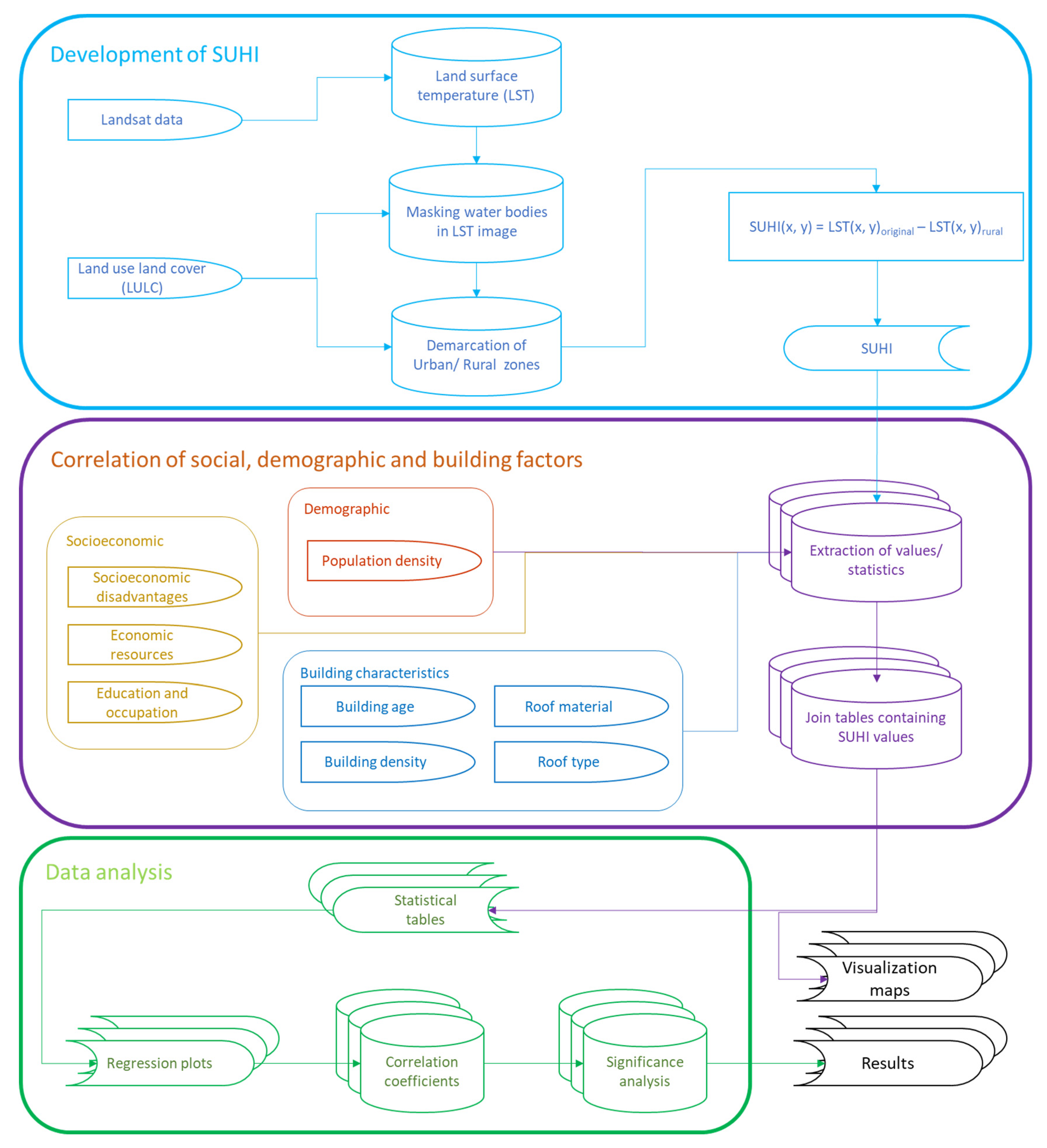
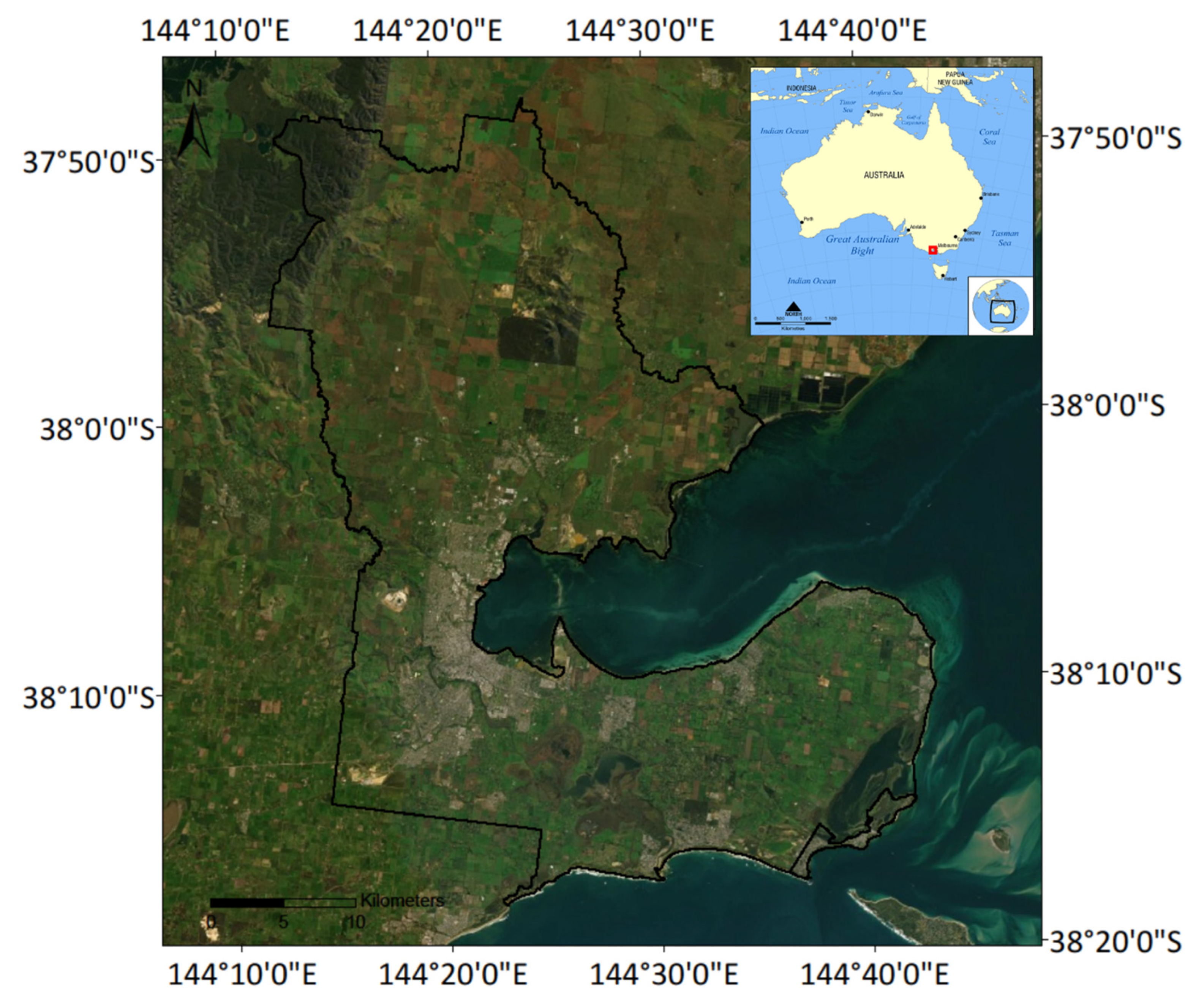
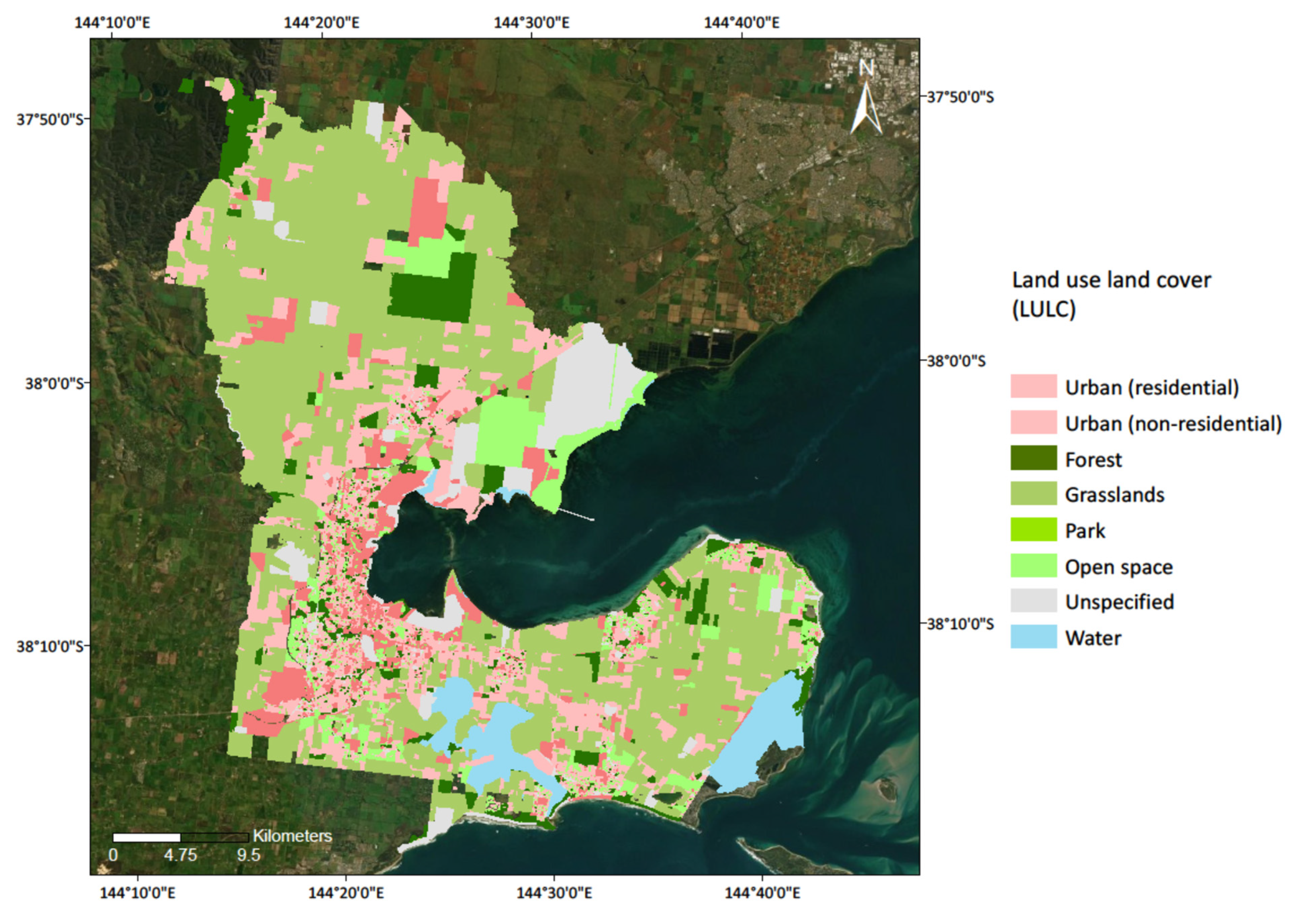
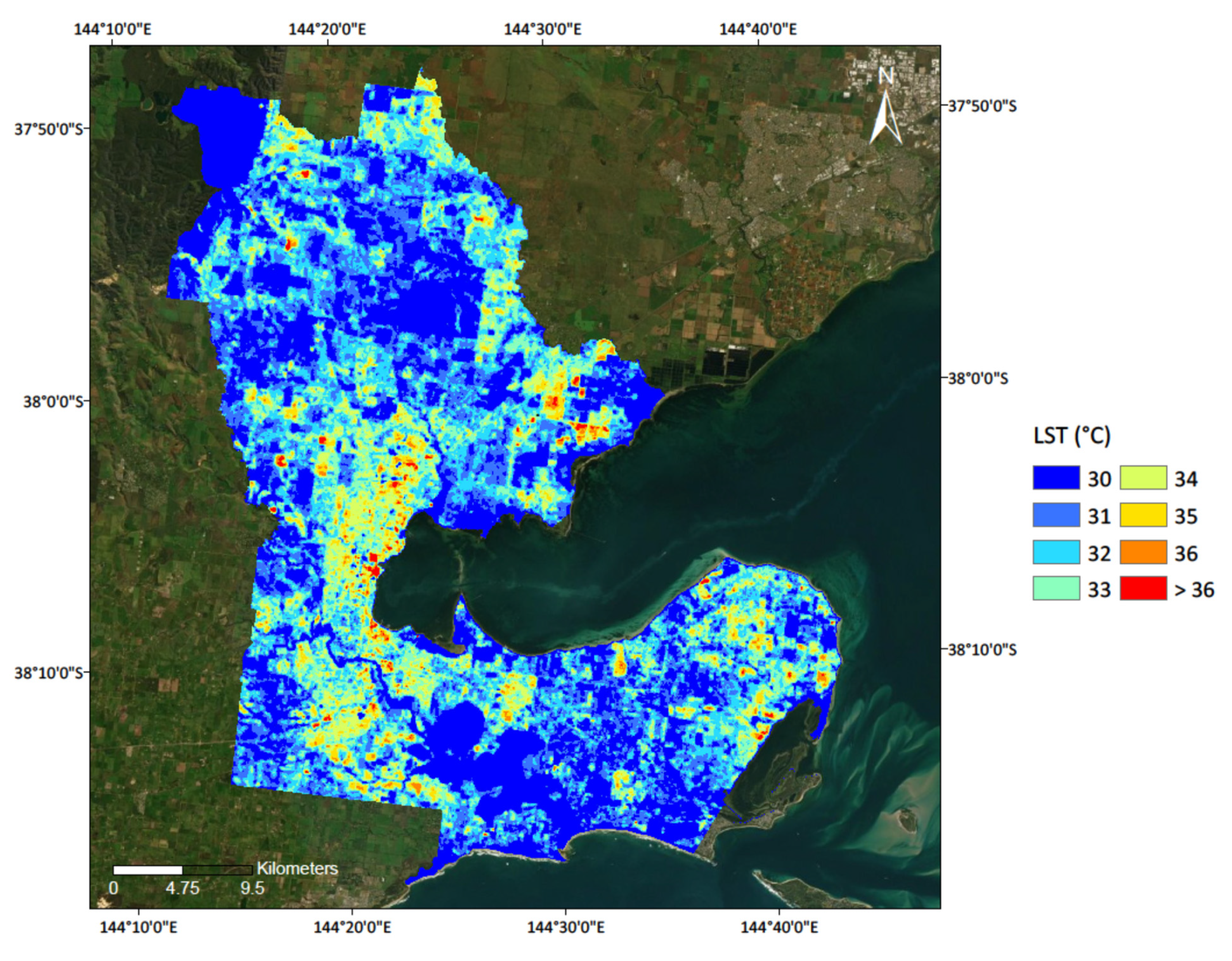
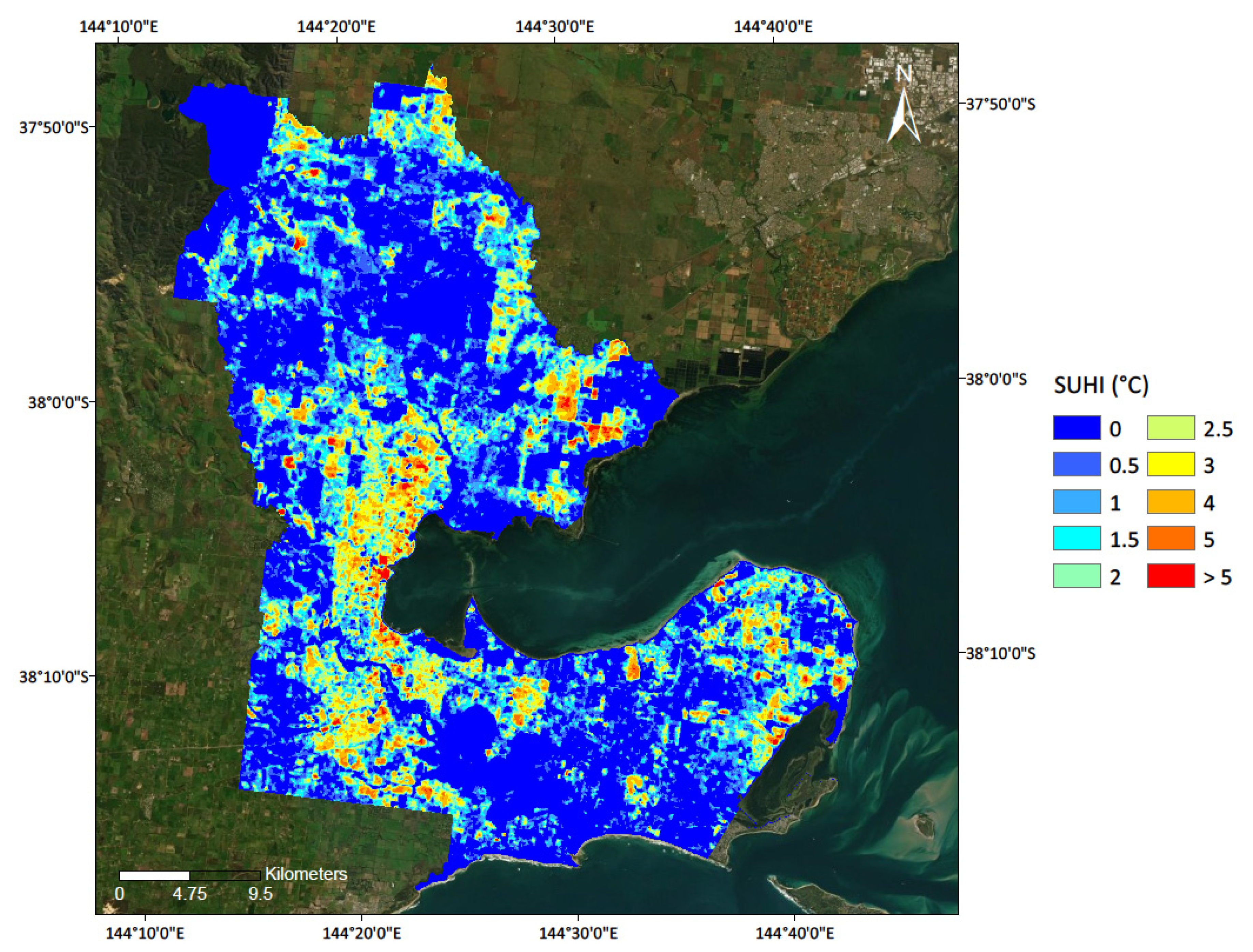
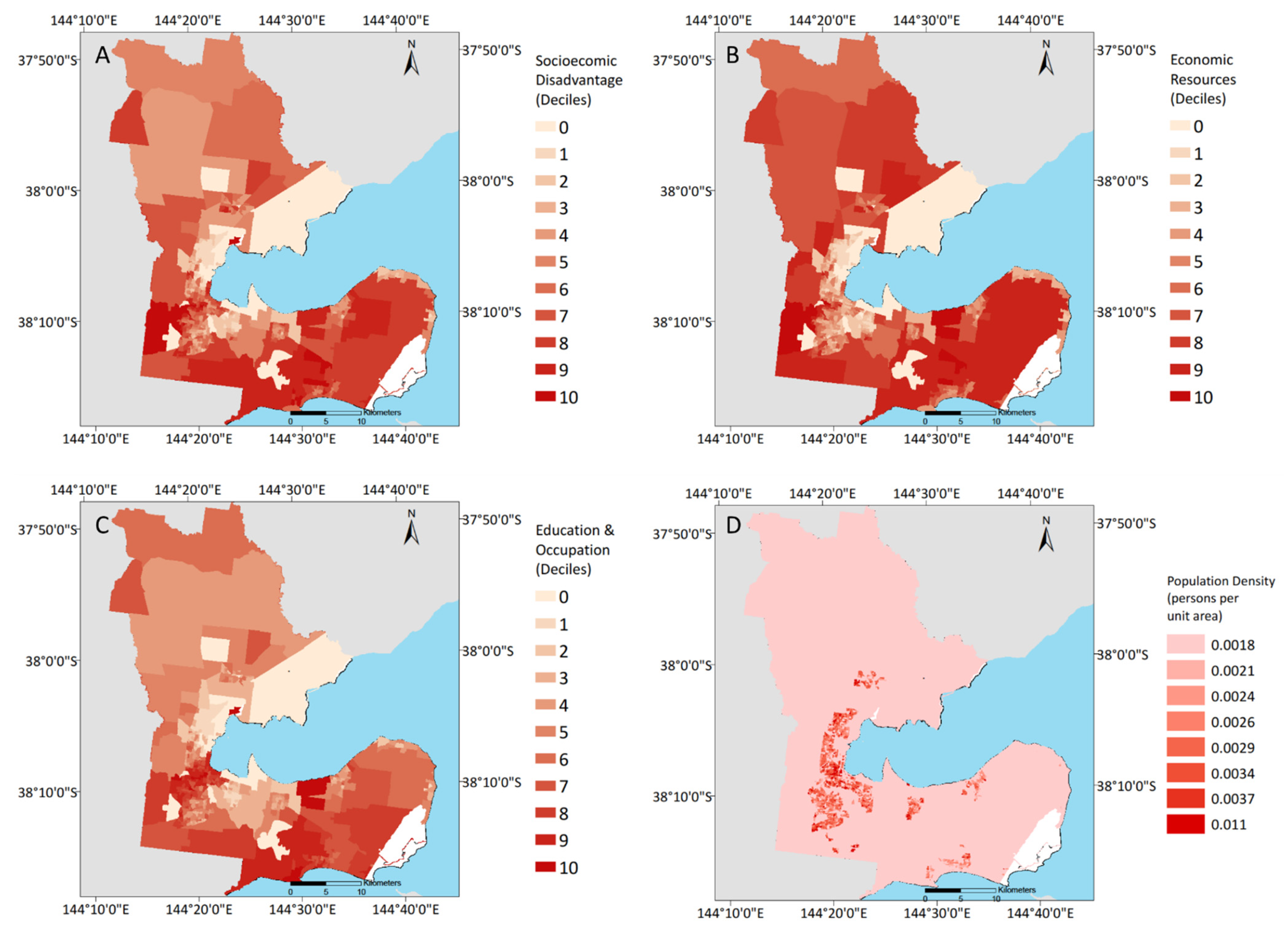
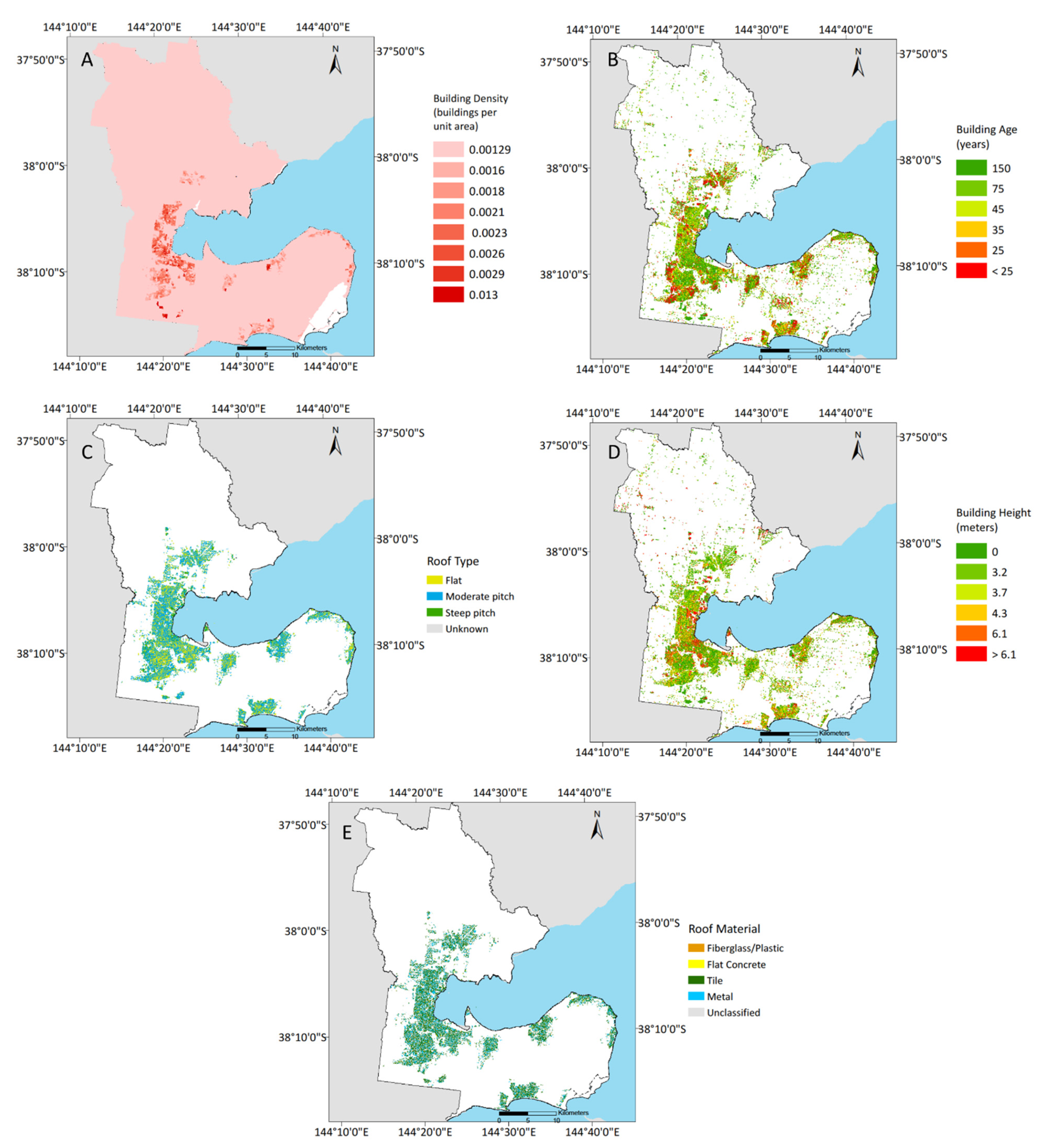
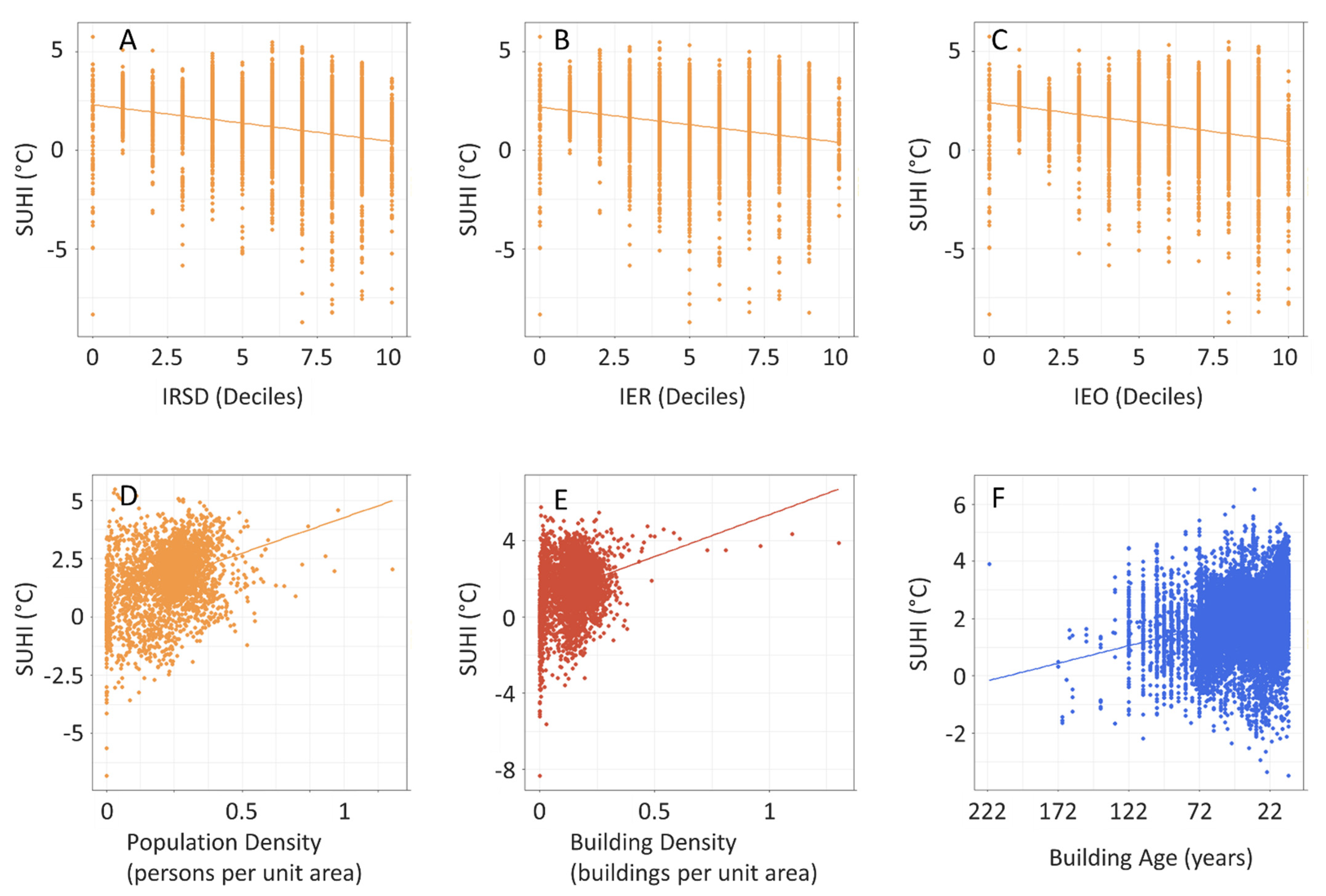
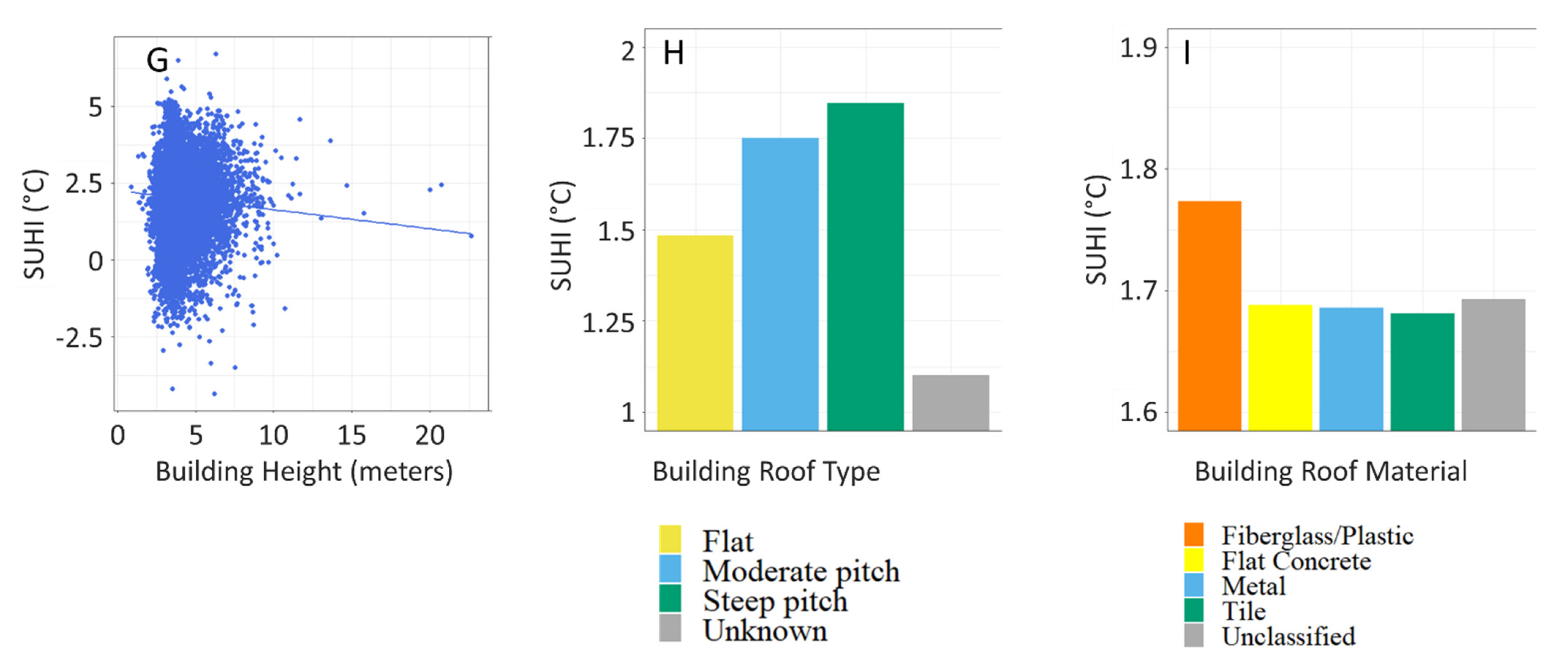
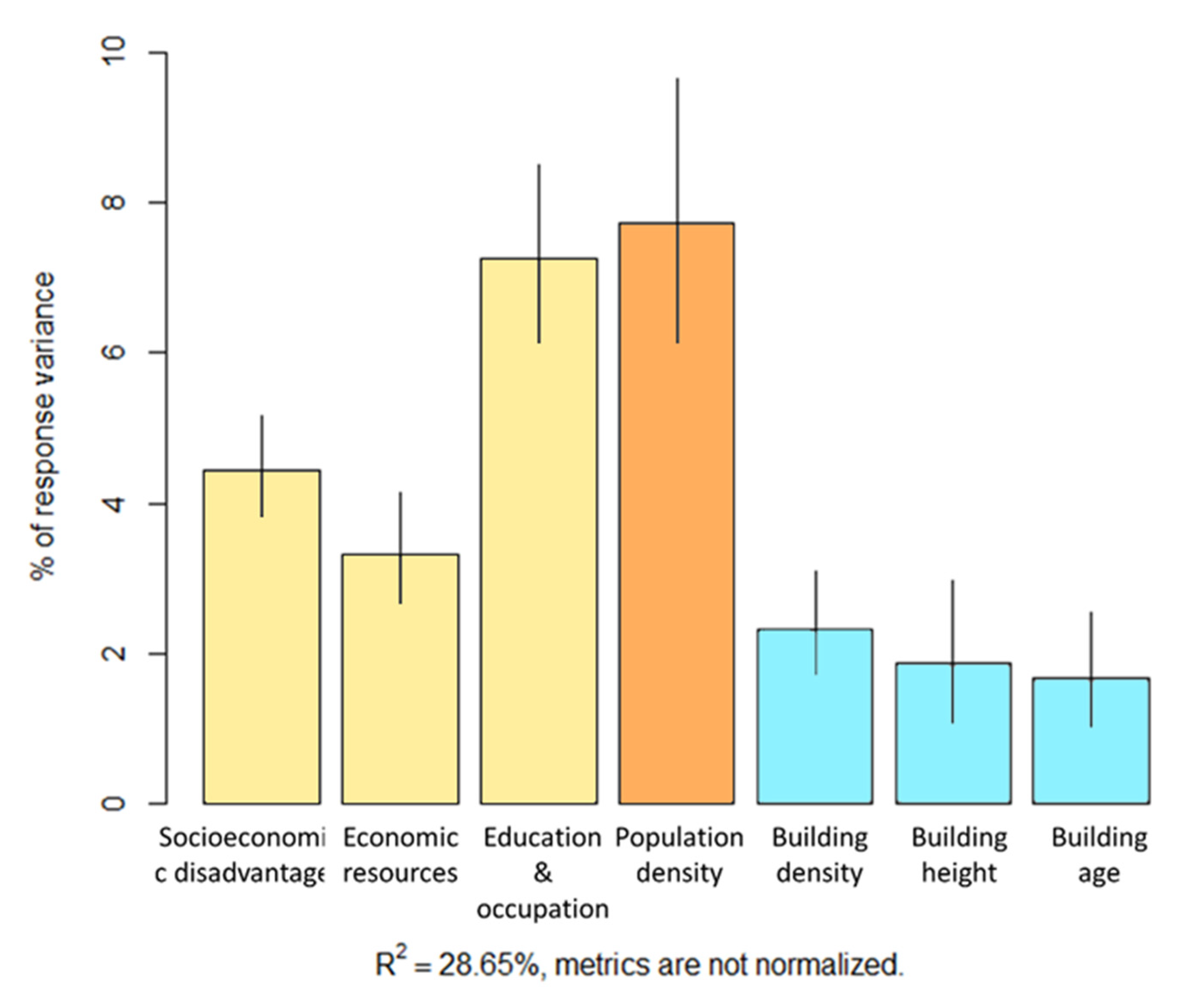
| SUHI Factors | Attributes | Slope | R2 | p-Value |
|---|---|---|---|---|
| Building variables | Building height | −0.06 | 0.004 | <0.01 |
| Building age | +3.351 × 10−5 | 0.07 | <0.01 | |
| Building density | +407 | 0.07 | <0.01 | |
| Building roof Type | - | - | - | |
| Building roof Material | - | - | - | |
| Demographic variables | Population density | +407 | 0.12 | <0.01 |
| Socioeconomic variables | Socioeconomic disadvantage | −0.19 | 0.08 | <0.01 |
| Education and occupation | −0.19 | 0.06 | <0.01 | |
| Economics resources | −0.18 | 0.09 | <0.01 |
| SUHI Factors | Attributes | Relative Importance (R2) | Average Coefficient | Confidence Interval (CI) | p-Value |
|---|---|---|---|---|---|
| Building variables | Building height | 0.019 | +0.012 | 0.0188 | <0.01 |
| Building year | 0.017 | +0.007 | 0.0154 | <0.01 | |
| Building density | 0.023 | +448 | 0.0138 | 0.912 | |
| Demographic variables | Population density | 0.078 | +369 | 0.0351 | <0.01 |
| Socioeconomic variables | Socioeconomic disadvantage | 0.045 | −0.172 | 0.0072 | <0.01 |
| Education and occupation | 0.073 | −0.181 | 0.0237 | <0.01 | |
| Economics resources | 0.033 | −0.165 | 0.0147 | <0.01 |
Publisher’s Note: MDPI stays neutral with regard to jurisdictional claims in published maps and institutional affiliations. |
© 2022 by the authors. Licensee MDPI, Basel, Switzerland. This article is an open access article distributed under the terms and conditions of the Creative Commons Attribution (CC BY) license (https://creativecommons.org/licenses/by/4.0/).
Share and Cite
Sidiqui, P.; Tariq, M.A.U.R.; Ng, A.W.M. An Investigation to Identify the Effectiveness of Socioeconomic, Demographic, and Buildings’ Characteristics on Surface Urban Heat Island Patterns. Sustainability 2022, 14, 2777. https://doi.org/10.3390/su14052777
Sidiqui P, Tariq MAUR, Ng AWM. An Investigation to Identify the Effectiveness of Socioeconomic, Demographic, and Buildings’ Characteristics on Surface Urban Heat Island Patterns. Sustainability. 2022; 14(5):2777. https://doi.org/10.3390/su14052777
Chicago/Turabian StyleSidiqui, Paras, Muhammad Atiq Ur Rehman Tariq, and Anne W. M. Ng. 2022. "An Investigation to Identify the Effectiveness of Socioeconomic, Demographic, and Buildings’ Characteristics on Surface Urban Heat Island Patterns" Sustainability 14, no. 5: 2777. https://doi.org/10.3390/su14052777
APA StyleSidiqui, P., Tariq, M. A. U. R., & Ng, A. W. M. (2022). An Investigation to Identify the Effectiveness of Socioeconomic, Demographic, and Buildings’ Characteristics on Surface Urban Heat Island Patterns. Sustainability, 14(5), 2777. https://doi.org/10.3390/su14052777








